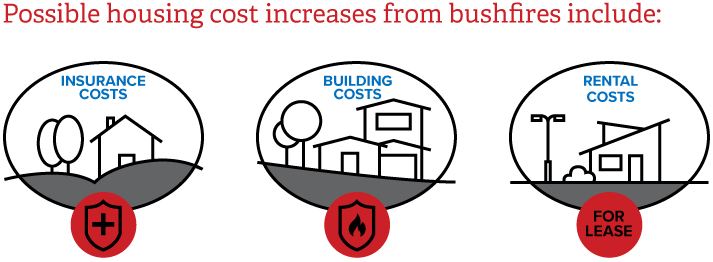The recent extended bushfire season across Australia has affected people living in rural and remote areas in many different ways: from having to evacuate from their home, to missing work when fire closes down local businesses, to the disaster of having their home and possessions destroyed by fire, to the health risks of living with bushfire smoke for long periods of time. In addition to these more direct impacts, the new nature of fire seasons will change the economic viability of living in rural and remote bushfire prone areas.

For home owners and buyers
One of the attractions for households about living (and working) in regional, rural and remote Australia (where household disposable income is 18 per cent lower than in major towns and cities) has been the ability to buy their own home (such as bush blocks where their children can have room to develop) at prices that are significantly lower than in larger towns or capital cities.
However, one of the key impacts of more bushfires will be the matter of increasing insurance costs on housing, with a spokesperson for the Insurance Council Australia stating that ‘it was a matter of not if, but when, insurance premiums would start to rise’ and media reports indicating insurance costs in bushfire zones already increasing by around 50 per cent.
The Bushfire Building Council of Australia estimates that, across Australia, two million properties are within 100 metres of bushland (which puts them at greater risk of being destroyed by bushfire). As a consequence, many households may find their insurance premiums becoming prohibitive.
For those who own their property outright this may result in householders choosing to underinsure their properties. This means if there was a bushfire the lost property would not be able to be rebuilt and the household would have to move away from the area.
Householders looking to buy with a mortgage will have no option but to pay any increased insurance premiums, as having adequate insurance is a requirement of all commercial lenders. Longer term this may result in many households (particularly those on lower incomes) being unable to buy homes in bushfire zone areas and having to remain in the private rental market if they choose to stay in the area.
For home owners who want to reduce insurance premiums building a ‘fire-resistant’ dwelling may appear to be an option. However, the cost of building ‘fire-resistant’ dwellings can be considerably more expensive than building a standard dwelling.
The Bushfire Building Council of Australia estimates that, across Australia, two million properties are within 100 metres of bushland (which puts them at greater risk of being destroyed by bushfire). As a consequence, many households may find their insurance premiums becoming prohibitive.
For example, a house built by a volume builder in an accessible area (i.e. outer suburb of a major city) could cost under $250,000 (in 2019, not including land) However, building a dwelling to the standards required in the high-risk bushfire flame zone (i.e. BAL-FZ) will cost significantly more—at least $100,000 more than the cost of building a typical four bedroom home not in a fire risk area.
When considered with the higher costs of building in rural and remote areas, this could easily lead to house builds costing in the $500,000 to $600,000 range (as quoted in the media)—not including the value of the land. Such building costs are unaffordable for households on lower incomes.
For renters
Rents for properties in rural and remote bushfire prone areas are likely to increase as there may be greater demand from both households who have lost their homes and want to stay in the area as well as households who can’t afford to buy or build the more expensive housing required to cope with bushfires.
To maintain affordable insurance premiums, property investors may need to upgrade their rental properties to the appropriate bushfire standard required for the zone the house is in. These upgrade costs are likely to be passed on to tenants through higher rents.
One outcome is that if lower income households can’t buy a home and are forced into the more-expensive local private rental market, staying in ‘lower wage’ rural and remote areas becomes less feasible.

